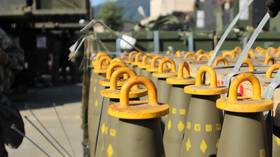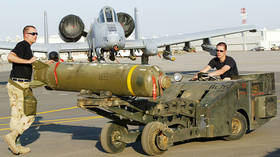Ukraine begins using US-provided cluster munitions – WaPo

Kiev has begun using US-made cluster artillery shells, the Washington Post reported on Thursday, citing unnamed Ukrainian officials familiar with the matter. Specifically, the US-provided munitions are being used in “a push to break up” Moscow’s defensive lines amid efforts to reinvigorate Kiev’s stalled counteroffensive, according to the outlet.
The US recently opted to provide the controversial cluster munitions to Ukraine, despite them being banned in over 100 countries and widespread opposition from human rights groups. The so-called dual-purpose improved conventional munitions (DPICMs), namely in the form of 155mm artillery shells, arrived in Ukraine last week.
US President Joe Biden described the move as a stopgap measure, claiming that Washington and its allies were running short on regular munitions of the standard NATO caliber to prop up Kiev in the ongoing conflict with Moscow.
The move, however, has proven to be controversial even for Washington’s allies, with multiple countries, including the UK, Canada, and Spain, criticizing the decision. The UN has opposed the move as well, expressing concerns of the potential use of such ordinance on civilians.
Cluster shells contain multiple smaller submunitions – when fired, they open up in the air and pelt a large area with said bomblets. The munitions exhibit higher dud rates, with unexploded submunitions posing a threat for years on. The US had to circumvent its own rules to make the delivery happen, as it had prohibited exports of weaponry with dud rates of more than 1%. The DPICMs delivered to Kiev, however, are said to have dud rates of at least 2.35%.
Washington insisted Kiev had promised to use the cluster weaponry responsibly, with Undersecretary of Defence for Policy Colin Kahl claiming it pledged not to use these munitions in “civilian-populated urban areas.”
The Ukrainian military, however, has a long account of indiscriminate use of controversial munitions, including cluster rockets with PFM ‘petal’ mines, claymore-style MON mines, artillery shells with flechettes and other weaponry, originating from its domestic stockpiles left from the Soviet times.
More than 100 nations agreed to ban cluster weaponry due to its tendency to leave behind unexploded submunitions, signing the Convention on Cluster Munitions (CCM) back in 2008. Neither Ukraine, nor the US – or Russia, however, are parties to the convention.
Moscow has condemned Washington’s decision to supply the controversial weaponry to Ukraine, promising to retaliate in kind and use “equivalent weapons.”
“It should be noted that Russia has cluster munitions, as they say, for all occasions. They are much more effective than American ones, their range is broader and more diverse,” Russian Defense Minister Sergey Shoigu said shortly after the delivery was first announced.













